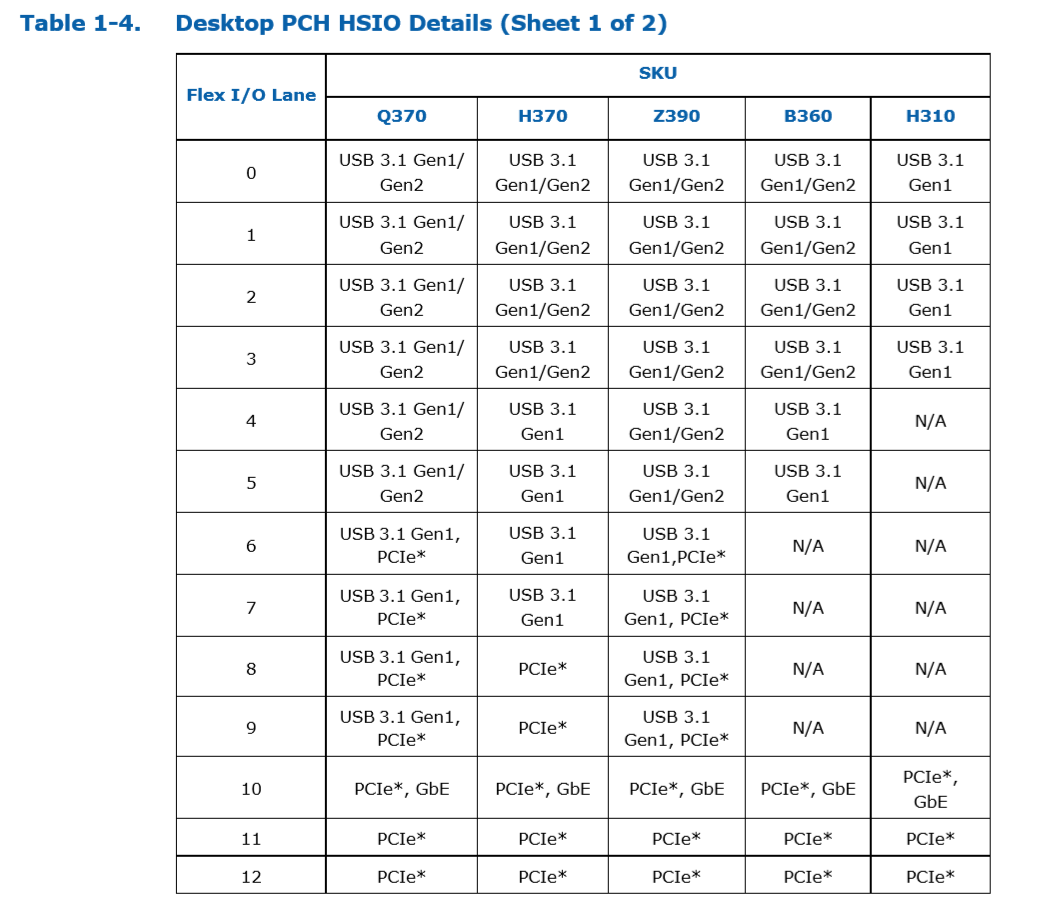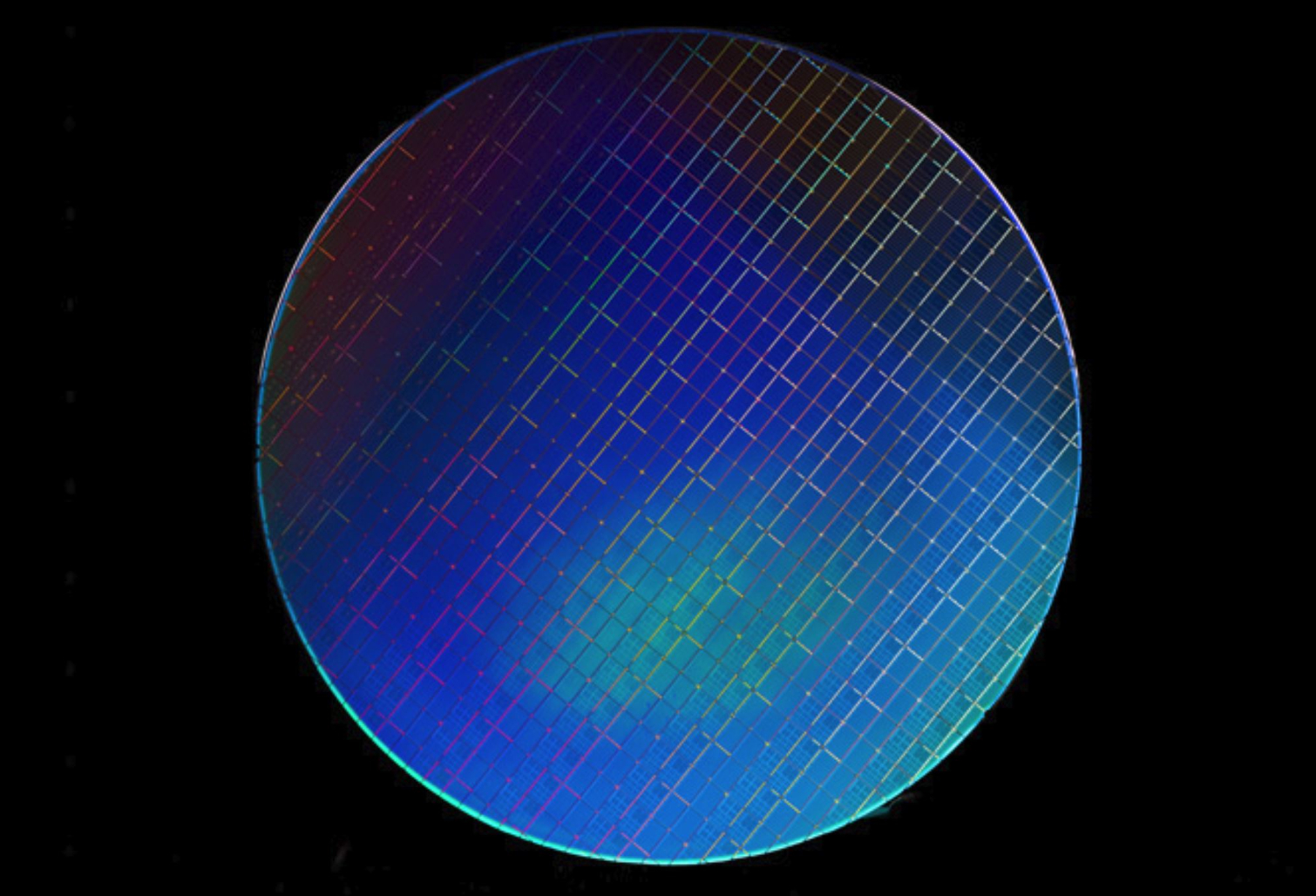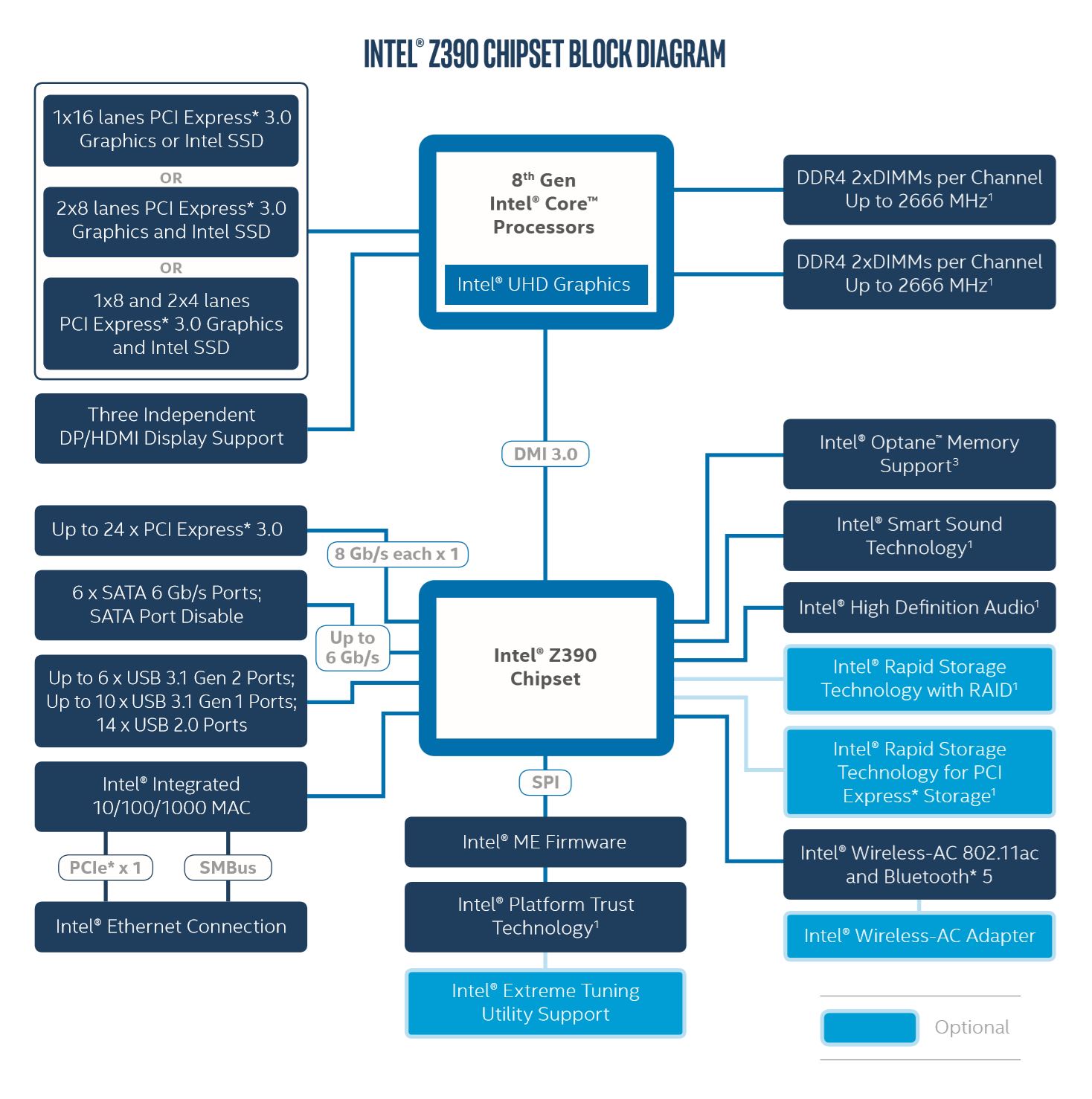Intel Sneaks Out Z390 Chipset Documents: Native USB 3.1 Gen2, Wireless-AC, Bluetooth 5 (Update)
Update, 5/24/18, 12:15pm PT: Intel added the Z390 to its official chipset documentation, which you can find here. Aside from the details we've already dug up, the documentation includes more information about the HSIO (High-Speed I/O) lanes, which we've included in an album below. Hat tip to PCGamesHardware for finding the update.
Intel has posted an Z390 Chipset Product Brief to its site with little fanfare. The document outlines the features of the new chipset, which largely mirrors the features of the new 300-series chipsets the company launched with its latest round of Coffee Lake processors. Unfortunately, the document doesn't confirm the new chipset will support the rumored eight-core mainstream desktop model, but given the information we've already gathered from multiple sources, it is almost a certainty.
Intel touts the Z390 chipset as compatible with eighth-generation processors. Intel has already listed the pending eight-core processors on its website, so we know they will also fall into the eighth-generation family of processors.
Bluechip, a German PC OEM, also recently accidentally posted a roadmap that indicated the Intel Z390 would appear at Computex with the eight-core processor to follow in Q3. Bluechip has since removed the roadmap, but you can see it here.
In April, Intel refreshed its 300-series chipset with the 14nm Cannon Lake PCH, whereas the Z370 chipset used a 22nm process node.
Intel's new PCH only dropped onto new H-, B-, and Q-series motherboards, which curiously left the Z370 platform (the only overclockable chipset of the bunch), with a slightly-outdated chipset. The new Z390 document doesn't reveal any new earth-shattering details. Instead, the chipset just brings the Z-series chipsets up to par with the new 300-series models.
| Intel 300 Series Chipset Features Table (April 2018 Updates) | ||||||
|---|---|---|---|---|---|---|
| Row 0 - Cell 0 | Z390 | Z370 | Q370 | H370 | B360 | H310 |
| DDR4 Overclocking | Yes | Yes | No | No | No | No |
| On-CPU PCI Express*3.0 Configuration(s) | 1X16 or 2X8 or 1x8+2X4 | 1x16 or 2x8or1x8+2x4 | 1x16 or 2x8or1x8+2x4 | 1x16 | 1x16 | 1x16 |
| Independent DisplayPorts / Pipes Support | 3/3 | 3/3 | 3/3 | 3/3 | 3/3 | 3/2 |
| Memory Channels / DIMMs per Channel | 2/2 | 2/2 | 2/2 | 2/2 | 2/2 | 2/1 |
| Processor Overclocking | Yes | Yes | No | No | No | No |
| Integrated Intel Wireless-ACSupport (CNVi) | Yes | No | Yes | Yes | Yes | Yes |
| Intel Optane Memory Support | Yes | Yes | Yes | Yes | Yes | No |
| Maximum High Speed I/O Lanes | 30? | 30 | 30 | 30 | 24 | 14 |
| Maximum USB 3.1 Ports: Gen 2 / Gen 1 | 6/10 | 0/10 | 6/10 | 4/8 | 4/6 | 0/4 |
| Maximum SATA 6Gb/s Ports | 6 | 6 | 6 | 6 | 6 | 4 |
| Maximum PCI Express* 3.0 lanes | 24 (v3.0) | 24 (v3.0) | 24 (v3.0) | 20 (v3.0) | 12 (v3.0) | 6 (v2.0) |
| Intel Rapid Storage Technology | Yes | Yes | Yes | Yes | Yes | No |
| Maximum Intel RST for PCIe Storage Ports (x2 M.2 or x4 M.2) | 3 | 3 | 3 | 2 | 1 | 0 |
| Intel RST PCIe RAID 0, 1, 5 | Yes | Yes | Yes | Yes | No | No |
| Intel RST SATA RAID 0, 1, 5, 10 | Yes | Yes | Yes | Yes | No | No |
| Intel RST for CPU-attachedIntel PCIe Storage | Yes | Yes | Yes | No | No | No |
The Z390 chipset comes with native support for USB 3.1 Gen2 (up to six ports). Intel also added support to the Z390 for Wireless-AC 2x2 160 MHz and Bluetooth 5. Intel integrated the MAC into the chipset, but it still requires a PHY for operation. Intel offers its own CNVi module as the other half of the integrated solution, but the company also supports third-party solutions. The connection provides up to 1,700 Mbps of bandwidth, provided your router supports it. We've covered the finer details of the new 300-series chipsets, which also include an improved audio DSP, in our launch article. Head there for more detail.
Get Tom's Hardware's best news and in-depth reviews, straight to your inbox.


Intel will undoubtedly provide more details about the Z390 chipset during Computex, and due to Intel's practice of launching new chipsets along with new processors, we might also learn about new additions to the eight-generation family.

Paul Alcorn is the Editor-in-Chief for Tom's Hardware US. He also writes news and reviews on CPUs, storage, and enterprise hardware.
-
TechyInAZ Reply20965697 said:What is intel high definition audio?
If I remember correctly, that's just Intels iGPU audio when you hook up a display via HDMI/DP. -
Sleepy_Hollowed Intel HD Audio is the audio codec from Intel that superseded AC 97. It's widely used on those that do not use Realtek's HD audio or any other manufacturer implemented audio.Reply
Intel's HD Audio standard is a bit more expensive and strict than others, so it wasn't as implemented as the AC 97, but I did see them in a bunch of boards, especially when Intel used to make mainboards. The specification has been around since 2004:
https://en.wikipedia.org/wiki/Intel_High_Definition_Audio -
Darkbreeze I almost don't get the point of USB 3.1 gen2 being pushed on boards, native or not. There are extremely few devices or hubs that are compatible, even though it's been out for years now. When USB 3.0 came out, there was wide support for it across the board within months, not so in this case.Reply
And to be clear, we're not talking "USB C", which USB 3.1 gen2 CAN be, but isn't in every case. We're talking the speed and power spec compatibility. I've looked and looked for devices and hubs to use with my Gen2 3.1 port on my motherboard and there are very few, and what there is, is VERY expensive. Not sure why peripheral hardware manufacturers are not getting this done, but at this point it seems like 3.1 Gen2 is senseless as a selling point until there is a wider adoption at the storage and device level. -
arpanet1981 Reply20969445 said:I almost don't get the point of USB 3.1 gen2 being pushed on boards, native or not. There are extremely few devices or hubs that are compatible, even though it's been out for years now.
As compared with USB 3.2 Gen 2x2? I assume that the general goal is to support 10 GBASE-T USB ethernet adapters, faster storage arrays, etc. It would be nice if everyone went to the highest current standards, but, planned obsolescence being what it is, things usually take 3 years longer than someone might expect.
-
boe INTEL - WAKE THE F' UP!!! It is 2018 - we should not have a PCIe 4x bottleneck at the DMI chipset. We should be able to load a motherboard with 4 16x slots with 4 16x cards running at a full 16x on each slot. Is intel asleep at the wheel still? You'd think AMD taking a bite out of their pie would get them to sit up and take notice.Reply -
stdragon Reply20968566 said:I see no mention of ECC memory support.
And you wont. Intel specifically, explicitly, segments that market. ECC is reserved for the Xeon class where they can up-sell workstation and server class hardware.
Want ECC for consumer use on a budget? Go AMD. -
jimmysmitty Reply20977384 said:INTEL - WAKE THE F' UP!!! It is 2018 - we should not have a PCIe 4x bottleneck at the DMI chipset. We should be able to load a motherboard with 4 16x slots with 4 16x cards running at a full 16x on each slot. Is intel asleep at the wheel still? You'd think AMD taking a bite out of their pie would get them to sit up and take notice.
Who is going to run 4 GPUs especially with CFX and SLI both on life support?
No one offers more than 2x8 on consumer boards. On the HEDT market you can normally get a decent amount but even then its pointless since again support for SLI/CFX is not that great.
20996869 said:20968566 said:I see no mention of ECC memory support.
And you wont. Intel specifically, explicitly, segments that market. ECC is reserved for the Xeon class where they can up-sell workstation and server class hardware.
Want ECC for consumer use on a budget? Go AMD.
ECC is pointless for the majority of consumers unless they are a pro-sumer and in that respective most tend to go with Xeon/AMD equivalents anyways.


